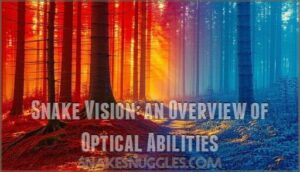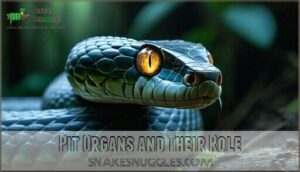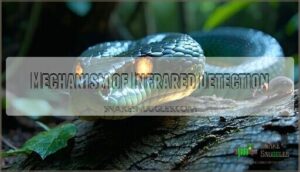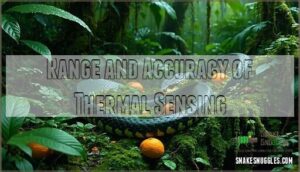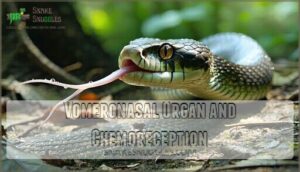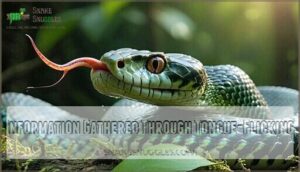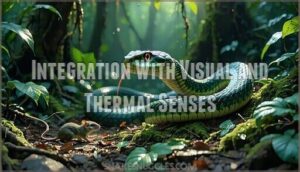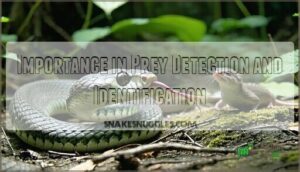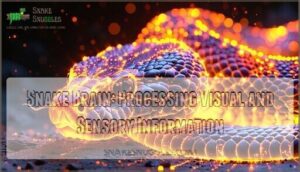This site is supported by our readers. We may earn a commission, at no cost to you, if you purchase through links.
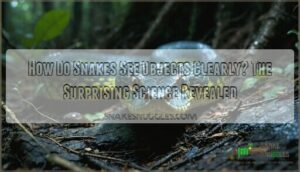
Their transparent spectacle scales protect their eyes while maintaining visual clarity, and their spherical lenses provide sharp focus compared to other animals.
Snakes possess more rod cells than cone cells, making them highly sensitive to movement and changes in light.
Many species also use specialized pit organs that detect infrared radiation from warm-blooded prey, basically giving them heat vision that works even in complete darkness.
This combination of enhanced visual processing and thermal detection creates a remarkably effective system for object identification.
The intricate ways these sensory systems work together reveal fascinating evolutionary adaptations, including their ability to detect infrared radiation and utilize spherical lenses for sharp focus, making them highly sensitive to movement and changes in light.
Table Of Contents
- Key Takeaways
- How Do Snakes See Objects Clearly?
- Snake Vision: an Overview of Optical Abilities
- Infrared Sensing: Snakes’ Unique Heat Vision
- Tongue-Flicking: Enhancing Snakes’ Perception of Objects
- Snake Brain: Processing Visual and Sensory Information
- Enhancing Visual Clarity: Adaptive Mechanisms in Snakes
- Frequently Asked Questions (FAQs)
- Are snakes’ vision based on movement?
- Do snakes have clear vision?
- How do snakes recognize you?
- How do snakes see things?
- What is a snakes vision like?
- Can a snake see an object?
- Do snakes see with their eyes or tongue?
- Can snakes distinguish colors or are they colorblind?
- How does shedding affect a snakes eyesight?
- Do snakes have depth perception like humans do?
- Conclusion
Key Takeaways
- You’ll discover that snakes don’t have poor eyesight like many believe – their transparent spectacle scales actually protect their eyes while maintaining excellent visual clarity for detecting movement and changes in light.
- You can’t overlook their remarkable heat vision abilities – many snake species use specialized pit organs to detect infrared radiation from warm-blooded prey, giving them thermal imaging that works even in complete darkness.
- You’ll find that snakes combine multiple sensory systems for object identification – their eyes work together with heat-sensing organs and chemical detection through tongue-flicking to create a comprehensive awareness map of their surroundings.
- You should understand that snake vision varies dramatically between species – arboreal snakes have sharper eyesight for depth perception, while nocturnal species excel at detecting movement in low light conditions through specialized rod cells in their retinas.
How Do Snakes See Objects Clearly?
When you watch a snake track its prey, you’re witnessing nature’s most sophisticated multi-sensory system at work.
Unlike humans who rely primarily on sharp vision, snake eyesight combines several remarkable adaptations to achieve visual acuity that’s perfectly suited for survival.
Snake vision transcends simple sight, weaving together heat, movement, and chemical cues into nature’s ultimate survival toolkit.
Their eyes feature Fixed Focus lenses that can’t adjust like ours, but this limitation becomes an advantage.
The transparent Spectacle Clarity protects their eyes while maintaining clear sight.
Most snakes excel at Movement Detection, spotting the slightest flutter in grass or leaves that signals potential prey or danger.
Many species possess UV Perception, seeing colors beyond our visual spectrum.
Some even develop Binocular Vision for precise depth perception during strikes.
Snakes also use vibration sensitivity to detect prey.
This snake vision system integrates seamlessly with heat-sensing pit organs and chemical detection through tongue-flicking, creating a three-dimensional awareness map that makes how snakes see far more complex than simple eyesight alone.
Snake Vision: an Overview of Optical Abilities
You might think snakes can’t see much without eyelids, but their vision system works differently than yours.
These reptiles have developed unique optical adaptations that let them detect movement, colors, and even heat signatures with remarkable precision.
Snake Eye Structure and Function
Unlike mammals, you’ll find that snake eyes work differently than yours. Spectacle Protection covers each eye with a transparent scale instead of eyelids, while their spherical Lens Shape provides sharp Fixed Focus vision. Specialized Retina Cells adapt to varying light conditions, and Pupil Control regulates light entry.
Some species even exhibit UV vision capabilities, advantageous in bright environments.
- Snake eye anatomy features a protective spectacle that never blinks—it sheds with their skin
- Snake vision relies on a fixed lens system that can’t adjust focus like human eyes
- Snake retina contains specialized cells that automatically adjust to different lighting conditions
Visual Acuity in Different Snake Species
Now that you understand snake eye structure, let’s examine how different species achieve varying levels of visual sharpness.
Snake visual acuity depends heavily on their lifestyle and habitat needs.
- Arboreal Vision: Tree-dwelling snakes like vine snakes possess exceptional Diurnal Vision, with visual acuity reaching 20/100 to 20/200 on standard eye tests.
- Nocturnal Sight: Night-active species have reduced visual clarity but enhanced light sensitivity through specialized vertical pupils.
- Burrowing Vision: Underground snakes show the poorest Habitat Acuity, often seeing only light and dark rather than detailed images.
Some species, like pit vipers, use infrared radiation detection to locate prey.
Color Perception in Snakes
Snake color vision works differently than yours.
Most snakes have dichromatic vision, seeing mainly blue and green wavelengths through two cone types rather than your three.
They can’t perceive red like you do, but many detect UV light that’s invisible to you.
This color range affects their behavioral impact – helping them spot prey, avoid predators, and navigate their world using their specialized cone cells.
Some snakes can even detect infrared radiation through pit organs.
Adaptation to Various Light Conditions
Light levels constantly change throughout the day, but snakes have mastered the art of visual adaptation. Their eyes function like sophisticated cameras, automatically adjusting to whatever lighting conditions they encounter.
Snake vision shines through remarkable adaptations that let them see clearly whether it’s blazing daylight or pitch-black darkness. Their spectral sensitivity covers wavelengths beyond human perception, while specialized pupil shapes control light intake with precision.
Here’s how these adaptations work:
- Nocturnal vision relies on high rod cell density for enhanced light sensitivity
- Diurnal vision uses cone cells optimized for bright light spectrum detection
- Pupil shapes range from round to vertical slits, regulating light entry
- Snake eyes contain specialized retinal cells that adjust sensitivity automatically
- Snake sight processes different wavelengths simultaneously for maximum clarity
These mechanisms guarantee snake nocturnal vision and snake diurnal vision both perform exceptionally well in their respective environments.
Comparison With Other Reptile Vision
Reptile vision showcases fascinating diversity compared to snake eyesight.
Lizards change lens shape for focusing, while snakes move their entire lens like cameras.
Chameleons boast independent eye movement and panoramic vision.
Geckos excel at nocturnal color perception with stenopaic pupils.
Turtles use UV light for underwater food detection.
Crocodilians possess excellent visual acuity above water.
This reptilian evolution demonstrates varied adaptations across species.
Infrared Sensing: Snakes’ Unique Heat Vision
You’ll discover that some snakes possess an extraordinary ability that goes far beyond ordinary vision – they can literally see heat.
This remarkable infrared sensing capability transforms how certain snake species detect and track warm-blooded prey, even in complete darkness.
Pit Organs and Their Role
Heat-sensing pit organs function as biological thermal imaging systems, positioning themselves strategically between the eye and nostril.
These specialized sensors contain TRPA1 proteins that detect infrared radiation from warm-blooded prey, enabling nocturnal hunting with remarkable precision.
Pit organ evolution has transformed certain snake families into thermal predators, making prey detection possible even in complete darkness through advanced thermal detection capabilities.
Mechanism of Infrared Detection
Infrared detection works through specialized TRPA1 proteins that function as molecular thermostats within pit organ membranes.
When infrared radiation strikes these heat-sensitive channels, they open instantly, generating electrical signals your brain interprets as thermal imaging.
This sophisticated heat signature visualization system transforms invisible thermal energy into actionable hunting data, giving snakes their remarkable infrared sensing capabilities for precise thermal detection.
Range and Accuracy of Thermal Sensing
Thermal sensing puts snakes in the detection distance league of their own. Pit vipers track warm-blooded prey up to one meter away, while pythons and boas sense heat at half that range. Their temperature threshold precision hits 0.003°C differences.
Environmental factors affect performance:
- Pit location between eyes and nostrils optimizes targeting accuracy
- High humidity reduces thermal contrast detection
- Prey size influences heat signature visibility
- Dense vegetation blocks infrared radiation pathways
This snake vision enhancement transforms hunting into thermal warfare.
Evolutionary Advantages of Heat Vision
When you’ve got heat-sensing abilities, nocturnal hunting becomes your secret weapon.
Snake vision combined with infrared radiation detection through pit organs creates unmatched prey detection advantages.
This sensory integration offers four key evolutionary benefits:
- Nocturnal Hunting – Strike accurately in complete darkness when warm-blooded prey is most vulnerable
- Thermal Camouflage Detection – Spot hidden mammals despite their visual camouflage attempts
- Habitat Adaptation – Thrive in diverse environments from dense forests to rocky terrain
- Energy Efficiency – Reduce failed strikes through precise infrared vision targeting
Differences Among Snake Families
Why don’t all snakes hunt the same way? Snake families differ dramatically in their visual acuity and sensory integration.
Vipers excel with precise pit organs for thermal detection, while pythons and boas use similar heat-sensing abilities for constriction hunting. Colubrids rely primarily on traditional snake vision without infrared capabilities.
These differences in pupil shape and habitat vision directly influence their hunting styles across species. Snakes use their pit organs to detect infrared radiation, allowing them to hunt in complete darkness with the aid of infrared capabilities and thermal detection.
Tongue-Flicking: Enhancing Snakes’ Perception of Objects
You’ve probably watched a snake flick its forked tongue and wondered what it’s actually doing – it’s not tasting the air like you might think, but collecting chemical information that creates a detailed map of its surroundings.
This tongue-flicking behavior works alongside the snake’s eyes and heat sensors to build a complete picture of nearby objects, prey, and potential threats.
Vomeronasal Organ and Chemoreception
You’ve witnessed snakes constantly flicking their tongues, but they’re actually collecting scent particles for chemical analysis.
The vomeronasal organ, also called Jacobson’s organ, processes these chemical cues through specialized chemoreception pathways:
- Pheromone detection for mate identification
- Prey chemical cues analysis for hunting success
- Scent-tracking abilities that surpass visual limitations
This tongueflicking behavior transforms snakes into living chemical detectors.
Further research explores vomeronasal organ products to enhance understanding.
Process of Tongue-Flicking
When you watch a snake’s forked tongue dart in and out, you’re witnessing nature’s most efficient chemical detective at work.
This rapid tongue flick frequency—occurring every few seconds—enables scent particle collection from the surrounding environment. The forked design maximizes surface area for gathering environmental cues, creating a detailed chemical map through chemoreception.
Many are curious about snake tongue products.
| Tongue Flicking Aspect | Function |
|---|---|
| Flick Rate | 150-200 times per hour during active periods |
| Collection Method | Forked tips gather airborne scent particles |
| Processing Location | Vomeronasal organ analyzes chemical data |
| Trail Analysis | Identifies prey routes and territorial markers |
Information Gathered Through Tongue-Flicking
When you watch a snake’s forked tongue flick out, it’s collecting invisible chemical signals from the air and ground.
These scent particles travel to the vomeronasal organ, where chemoreception transforms them into detailed environmental maps.
Through this scent analysis, snakes identify prey trails, detect predators, and navigate their surroundings with remarkable precision.
You can even find products related to it to learn more about the remarkable precision of a snake’s tongue function.
Integration With Visual and Thermal Senses
Picture yourself watching a snake hunt—it’s not just using one sense but orchestrating a complete sensory integration symphony.
Watch nature’s ultimate predator orchestrate sight, heat, and chemistry into lethal precision.
The snake’s brain seamlessly blends thermal cues from pit organs with visual cues and chemical data from tongue-flicking, creating what scientists call Multisensory Integration.
- Brain Region Overlap processes all three sensory streams simultaneously
- Thermal-Visual Overlap creates detailed heat and light maps
- Sensory Prioritization adjusts based on hunting conditions
- Enhanced Hunting accuracy through combined heat signatures and movement
- Infrared vision fills gaps where eyesight falls short
Importance in Prey Detection and Identification
You’ll discover how a snake’s tongue-flicking creates a sophisticated prey detection system that rivals high-tech sensors.
This chemoreception process enables precise prey camouflage detection and size discrimination through chemical analysis.
- Strike accuracy improves through chemical gradient mapping
- Distance estimation occurs via scent concentration patterns
- Ambush tactics rely on identifying prey movement trails
- Depth perception combines with chemical data for precise targeting
Snake Brain: Processing Visual and Sensory Information
Your brain processes visual information differently than most animals, combining limited eyesight with powerful heat detection and chemical sensing to create a complete picture of your surroundings.
This remarkable neural integration allows you to make split-second hunting decisions even when individual senses provide incomplete data, utilizing powerful heat detection.
Neural Pathways for Visual Processing
Through specialized neural pathways, your snake’s brain transforms visual signals into actionable information.
The optic tectum serves as the primary visual processing center, receiving data from the retina through complex neural encoding.
This remarkable visual cortex excels at motion detection, instantly identifying moving prey or threats.
Sensory integration occurs seamlessly, combining visual input with thermal and chemical data for thorough environmental awareness.
Integration of Multiple Sensory Inputs
The snake’s brain operates like a sophisticated command center, constantly weaving together sensory information from multiple sources.
This multisensory processing creates a thorough understanding of their environment through remarkable sensory integration.
Here’s how brain coordination orchestrates this sensory fusion:
- Visual data combines with infrared heat signatures for precise target identification
- Chemical signals from tongue-flicking merge with optical cues for enhanced tracking
- Sensory dominance shifts based on environmental conditions and hunting needs
- Neural pathways synchronize different inputs to trigger appropriate behavioral responses
- Perceptual synergy allows snakes to detect prey invisible to single-sense detection
Role of The Optic Tectum
You’ll find the optic tectum acts as your snake’s visual command center, where Tectal Visual Processing transforms raw sensory data into actionable information.
This brain region’s Tectal Circuitry coordinates visual processing with other neural pathways, enabling remarkable Tectum Sensory Integration that helps snakes detect movement and identify threats.
Through millions of years of Optic Tectum Evolution, this structure has become specialized for Tectum Prey Detection, making snakes incredibly efficient hunters despite their visual limitations.
Decision-Making Based on Sensory Data
The brain orchestrates sensory integration like a master conductor, weaving visual cues, thermal signatures, and chemical traces into split-second decisions.
When you’re hunting prey or evaluating threats, neural pathways fire rapidly, transforming raw sensory data into precise actions.
This sophisticated visual processing system enables threat assessment, shapes hunting strategies, guides navigation choices, and drives environmental adaptation through seamless decisionmaking processes.
Comparative Neuroanatomy With Other Reptiles
Examining reptilian evolution reveals fascinating insights about snake brain size and neural density.
While crocodilians possess the largest brains among living reptiles, snakes showcase remarkable sensory integration despite their compact brain regions.
Here’s how comparative neuroanatomy reveals these differences:
- Snake eyes process visual data through specialized optic tectum pathways
- Reptile vision varies dramatically across species and environmental adaptations
- Lizard vision often surpasses snake visual acuity in arboreal species
- Eye structure determines processing efficiency across reptilian families
Enhancing Visual Clarity: Adaptive Mechanisms in Snakes
You might be surprised to learn that snakes have developed several remarkable mechanisms to enhance their visual clarity despite their seemingly simple eyes.
These adaptive strategies include regulating blood flow in their eye spectacles, adjusting pupil shapes for different lighting conditions, and even using behavioral techniques to maximize their visual input.
Blood Flow Regulation in Eye Spectacles
When you’re observing snake vision, spectacle scales create remarkable Visual Acuity through sophisticated blood flow regulation.
These transparent protective covers enhance Spectacle Clarity by constricting blood vessels during critical moments, improving snake focusing mechanism.
This Evolutionary Advantage optimizes snake eyes performance before Shedding Impact temporarily reduces clarity, demonstrating how snake vision adapts through vascular control mechanisms.
Pupil Shape and Light Adaptation
Beyond blood flow regulation, snake pupils showcase remarkable adaptability through their diverse shapes and light-responsive mechanisms.
Each pupil morphology serves specific environmental needs, optimizing visual clarity across varying conditions.
- Vertical slits – Diurnal hunters like vipers contract these for bright light protection while maintaining sharp focus
- Round pupils – Nocturnal species maximize light intake for enhanced night vision capabilities
- Keyhole shapes – All-terrain snakes like vine species balance depth perception with movement detection
- Pinhole formations – Aquatic snakes reduce underwater light distortion for clearer prey tracking
Shedding and Its Effect on Vision
When snakes shed their skin, they’re basically upgrading their vision system.
The spectacle scales covering their eyes become cloudy before shedding, temporarily reducing visual clarity and causing behavioral changes like increased hiding.
Post-shed vision dramatically improves as fresh, transparent spectacles restore crystal-clear sight.
Lubrication importance during this process guarantees proper spectacle removal, while shedding frequency varies by species and age, directly affecting long-term eye structure maintenance and overall snake vision quality.
Shedding frequency varies by species and age, directly affecting long-term eye structure maintenance and overall snake vision quality, highlighting the importance of regular shedding for maintaining optimal eye structure.
Behavioral Adaptations for Improved Sight
If you’ve ever watched a snake, you’ll notice clever behavioral adaptations at work.
By adjusting head movement and body posture, they boost depth perception and visual clarity, especially during hunting strategies or defensive displays.
Camouflage use lets them stay hidden while tracking prey.
These subtle tricks help snake vision stay sharp, ensuring survival in their ever-changing environments, through effective use of visual clarity.
Species-Specific Visual Enhancements
Different snake species have evolved remarkable visual enhancements suited to their environments.
Arboreal vision in tree-dwelling species features enlarged eyes for superior depth perception, while nocturnal adaptations include rod-dominated retinas for low-light hunting.
Diurnal hunters possess enhanced color discrimination, and burrowing sight species develop specialized photoreceptors despite limited light exposure.
Desert snakes, for example, may exhibit behavioral adaptations to seek shade for cooling.
- Coachwhip snakes regulate blood flow in spectacles for ideal snake vision clarity
- Vine snakes feature keyhole-shaped pupils enhancing movement detection capabilities
- Aquatic vision species adapt lens curvature for underwater refraction differences
Frequently Asked Questions (FAQs)
Are snakes’ vision based on movement?
Movement detection takes priority over detailed vision in most snake species.
You’ll find they’re excellent at spotting moving prey and threats, but their ability to see stationary objects clearly varies substantially depending on the species and lighting conditions, which affects their detailed vision.
Do snakes have clear vision?
Like detectives piecing together clues from fragments, you’ll find that snakes don’t possess razor-sharp vision.
Their eyesight varies dramatically between species, with some achieving decent clarity while others see blurry outlines, relying heavily on movement detection and heat-sensing instead.
How do snakes recognize you?
Snakes recognize you through movement detection, heat signatures from their pit organs, and chemical scents they collect with their tongues.
They’ll remember your scent patterns and body heat more than visual details.
How do snakes see things?
With eyes sharper than medieval knights wielding telescopes, you’d see through transparent spectacle scales that protect their vision.
Snakes can’t adjust focus like you, but they detect movement excellently, sense infrared heat signatures, and perceive colors differently than humans, which includes sensing their infrared heat.
What is a snakes vision like?
Vision clarity varies dramatically among snake species, with arboreal types seeing better than burrowing ones.
You’ll find their fixed-focus lenses can’t adjust like yours, but specialized spectacle scales protect their eyes while maintaining moisture and clarity.
Can a snake see an object?
Contrary to popular belief that snakes can’t see well, you’ll find they’re quite capable of spotting objects.
They detect movement exceptionally well, though their vision lacks the sharp detail you’d expect, relying more on motion detection than fine visual clarity.
Do snakes see with their eyes or tongue?
You’ll discover that snakes primarily rely on their eyes for vision, while their tongues collect chemical information through smell and taste, creating a multi-sensory hunting system.
Can snakes distinguish colors or are they colorblind?
Imagine this scenario: you’re convinced your pet snake sees the world like an old black-and-white TV show, but you’d be wrong.
Most snakes possess color vision, detecting blue and green wavelengths through specialized cone cells in their retinas, though their color perception isn’t as vibrant as yours.
How does shedding affect a snakes eyesight?
Shedding temporarily impairs your snake’s vision as old spectacle scales cloud their eyes, creating a milky appearance. Once they’ve shed completely, their eyesight becomes clearer and sharper than before.
Do snakes have depth perception like humans do?
Unlike humans who enjoy sharp depth perception, you’ll find snakes have limited binocular vision since their eyes sit on opposite sides of their heads.
Though some species compensate with specialized adaptations.
Conclusion
Despite common misconceptions that snakes have poor eyesight, you’ve learned how these remarkable predators actually see objects with surprising clarity.
Their specialized eye structure, featuring transparent spectacles and spherical lenses, works alongside thermal detection to create exceptional visual capabilities.
You now understand how do snakes see objects clearly through their unique combination of enhanced rod cells for movement detection, infrared sensing through pit organs, and sophisticated neural processing that integrates multiple sensory inputs for precise object identification and successful hunting.
- https://www.nhm.ac.uk/discover/news/2016/september/study-sheds-light-on-snake-vision.html
- https://www.nature.com/articles/news.2010.122
- https://www.reptileknowledge.com/reptile-pedia/can-snakes-see-color
- https://news.umich.edu/u-m-study-uncovers-secret-color-language-of-snakes/
- https://neurosciencenews.com/color-vision-snake-genetics-23618/

